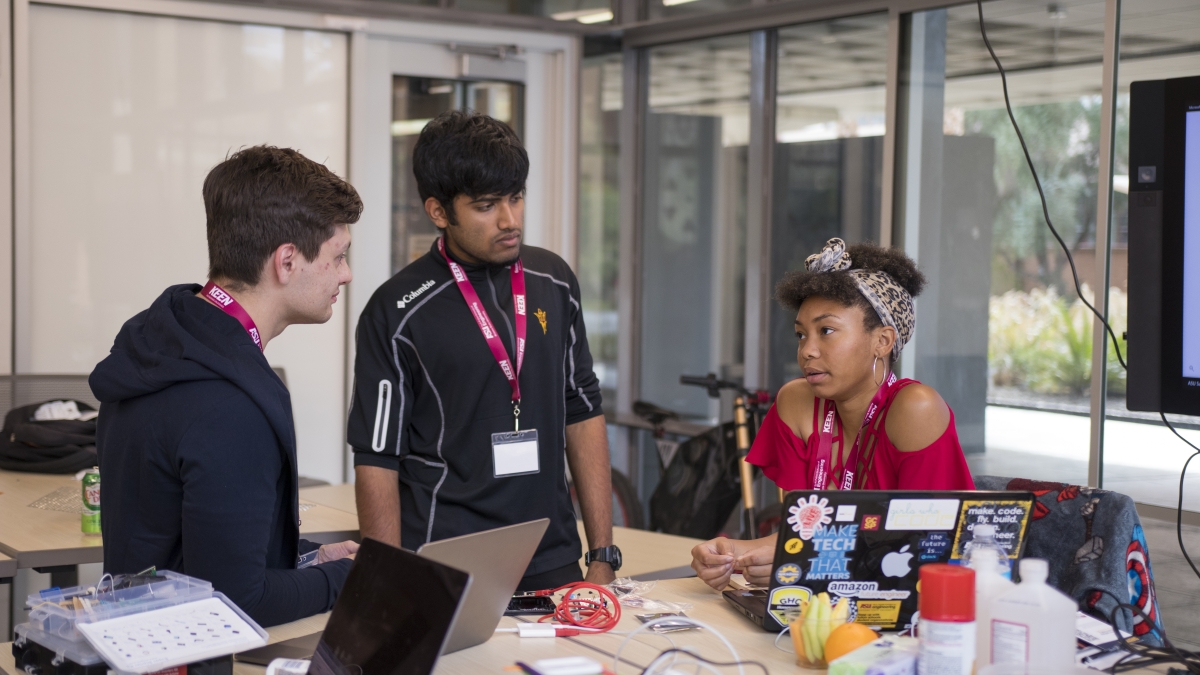ASU students innovate for the world, with the world at Devils Invent

ASU students worked with students from around the globe during Devils Invent – Invent for the Planet to solve high impact, global problems together. Photographer: Marco-Alexis Chaira/ASU
If you had the opportunity to make a difference in the world, would you clean up coastlines and oceans? Provide electricity to remote villages? Bring back a species from the edge of extinction?
More than 400 students from 13 universities around the world did just that during Invent for the Planet, a 48-hour global design challenge hosted by Texas A&M University.
The Arizona State University portion of the event was the latest in a series of engineering and design challenge events known as Devils Invent.
Students were encouraged to design, build and implement innovative solutions to challenging problem statements submitted by community, industry and university partners. Participants from Arizona to Myanmar interacted and collaborated together, learning what it means to be a global innovator.
The winning ASU team, known as Pee-Squared, consisted of three team members from the Ira A. Fulton Schools of Engineering: chemical engineering majors Carlos Zamora and Wyatt Del Carlo and computer science major Sahas Chitlange.
Pee-Squared chose to tackle the issue of providing electricity to remote villages.
“In developing countries, there is little to no access to electricity, so an off-the-grid solution is necessary that will allow students to study in the dark hours after the sun goes down,” Zamora said. “…Knowing this, we each knew that we needed to create a portable, modular, durable, inexpensive and easily maintained study lamp of sorts.”
The team created a miniature fuel cell out of the magnesium provided in fire starter kits as well as the nickel and copper present in coins such as nickels, dimes and quarters.
“We wanted to take advantage of the in-cell reduction potential that takes place in the ionized sodium and chloride ions that are present after dissolving salt in water,” explained Zamora. “This creates voltage across the different potentials, which enables a light to be powered. For Devils Invent, we created a 3-D print of what we had envisioned the finished product to look like.”
The team will continue the project in an Engineering Projects in Community Service FSE 494 course known as EPICS.
“We are thinking about increasing the number of compartments in the body of the lamp so we will be able to use more potential differences that create more voltage and amperage as a result,” Zamora said. “This means it is definitely plausible that we could power a study light using only salt and water, or urine, which was the initial idea because it is readily available.”
The team is looking to implement this design in parts of the world where it has the capacity to improve the educational experiences of young, aspiring students.
“We look forward to changing the design so it is capable of doing what the students in remote villages need it to do for their studies,” Zamora said. “This has such potential, and we hope to develop it so that it can meet that potential so it can help students in the maximum amount possible.”
The Devils Invent competition was a great experience for the team.
“This was my first Devils Invent competition, and it far surpassed my expectations,” Zamora.said. “I had a full 48 hours of fun both designing the model and working with it as well as passing the time with new and familiar faces from around campus. I highly encourage participation in Devils Invent because it is a very good introduction to what engineering really is and why it is so important.”
Devils Invent events occur multiple times each semester and are hosted by Entrepreneurship + Innovation at the Fulton Schools. The next one will take place March 23–25, on ASU’s Polytechnic campus. Sign up to participate or volunteer at entrepreneurship.engineering.asu.edu/devils-invent.
More Science and technology

Making magic happen: Engineering and designing theme parks
The themed entertainment industry is widespread and diverse, encompassing everything from theme parks to aquariums, zoos, water…

AI-equipped feeders allow ASU Online students to study bird behavior remotely
ASU Online students are participating in a research opportunity that's for the birds — literally. Online Bird Buddies is a…

National Humanities Center renews partnership with Lincoln Center for responsible AI research
The National Humanities Center has announced that Arizona State University's Lincoln Center for Applied Ethics is one of four…